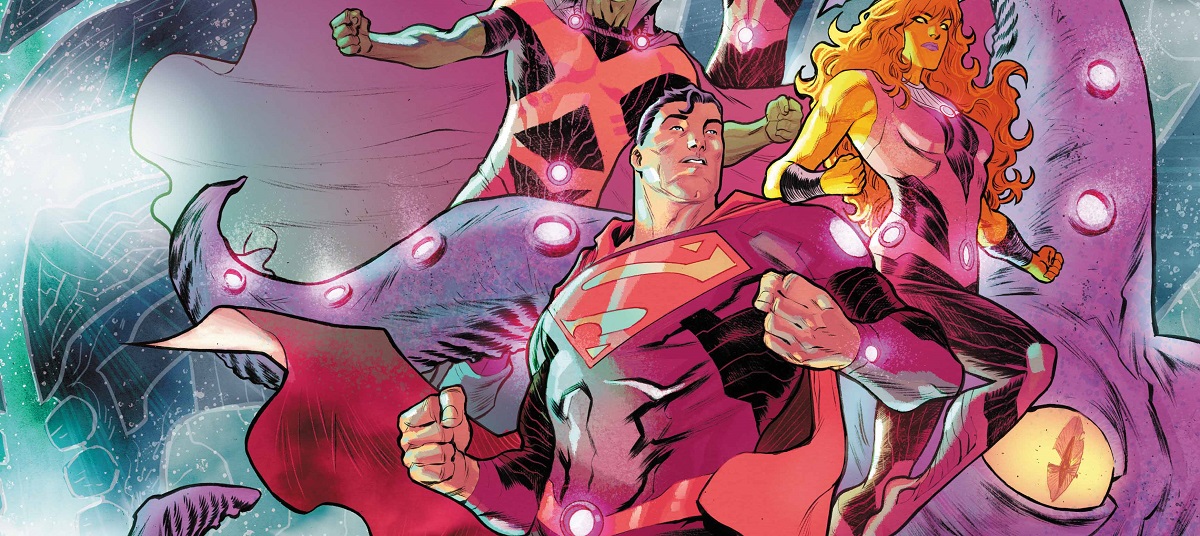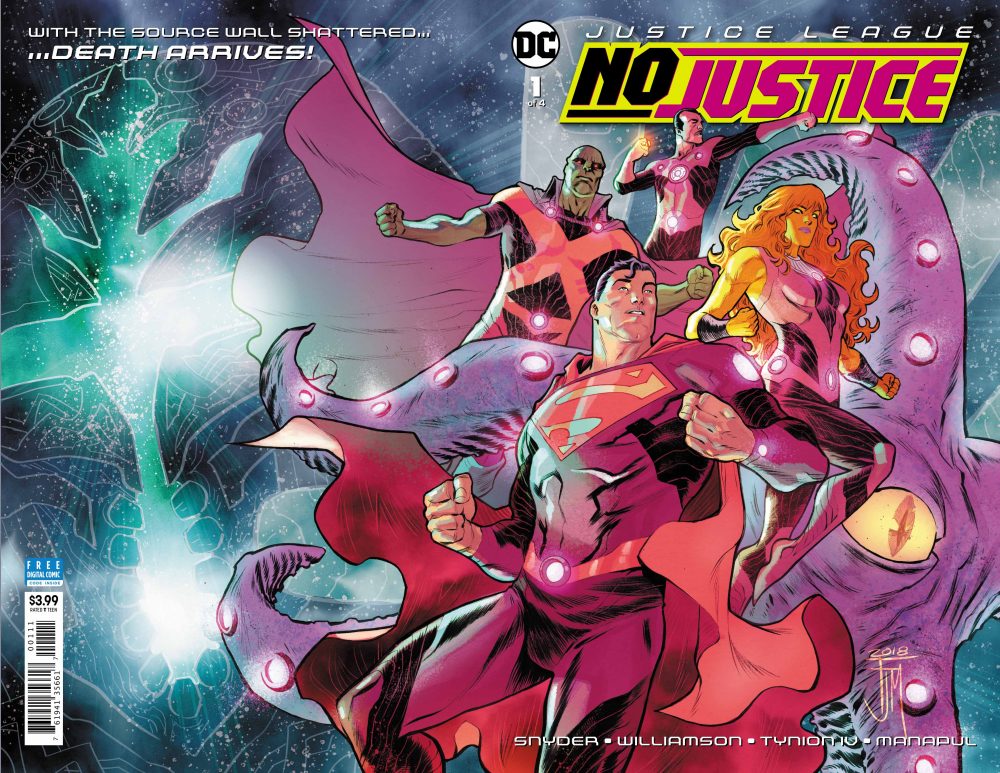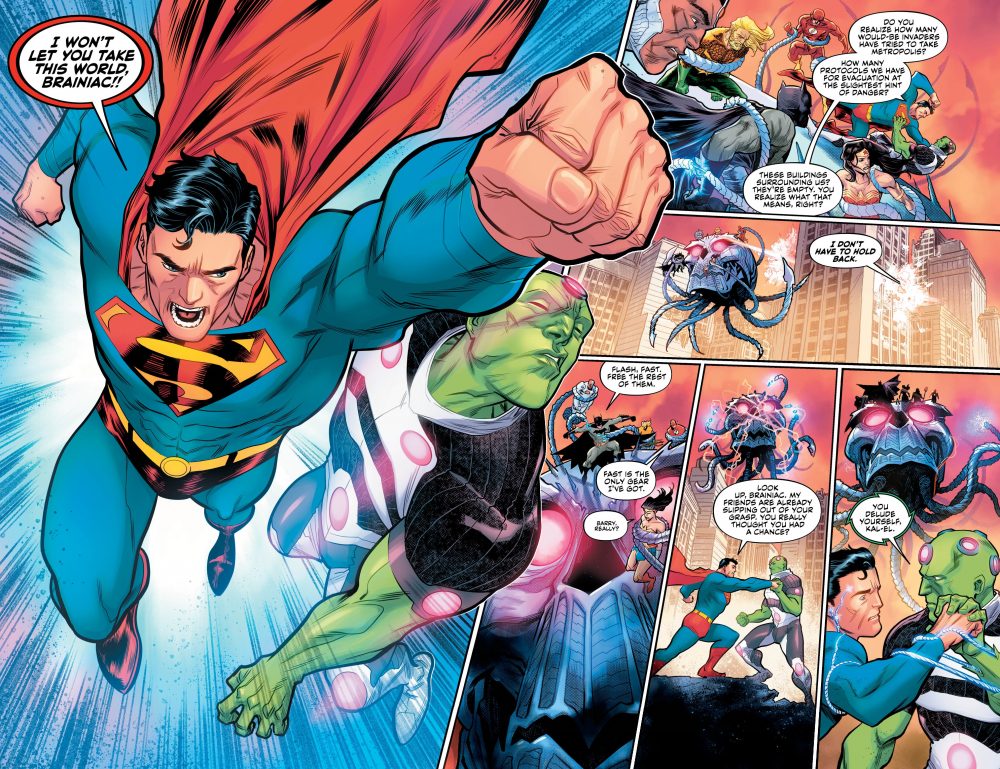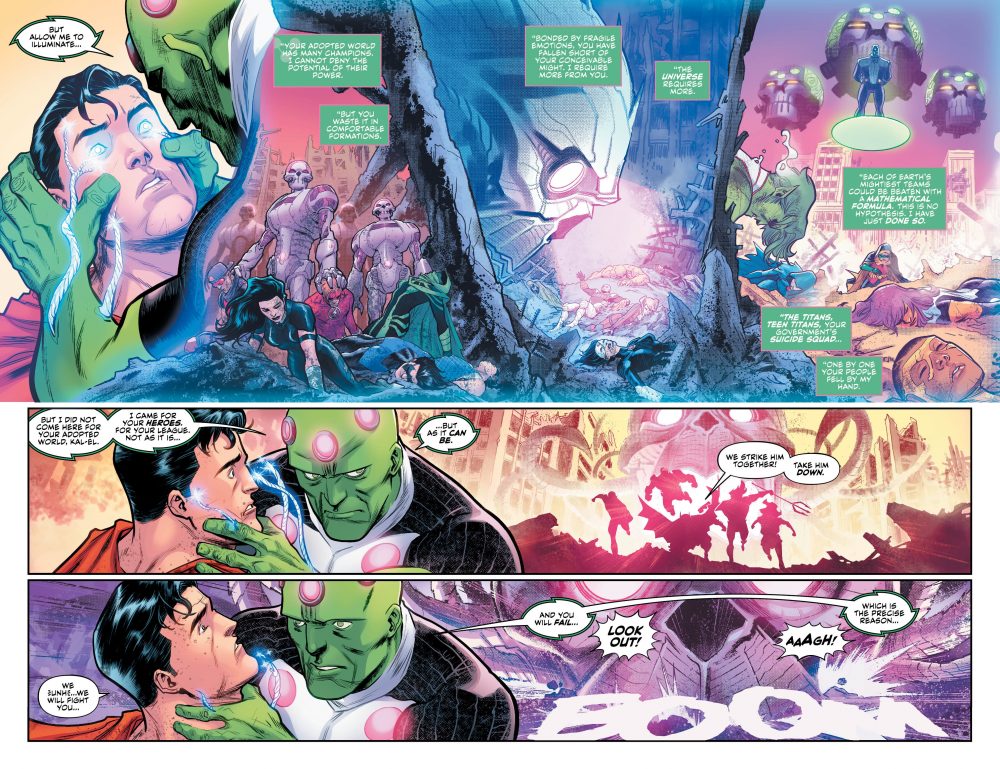DC Comics is trying something new. In the wake of their Rebirth initiative, the publisher has rapidly expanded its content to include diverse new imprints such as Young Animal, Wildstorm, Black Label, Ink, and Zoom. As their lineup expands, it can be hard to figure out what to pick up each week. That’s what the Comics Beat managing editor Alex Lu, entertainment editor Kyle Pinion, and contributor Louie Hlad are here to help you with.
THIS WEEK: Almost two weeks after the release of Avengers: Infinity War, I still find myself thinking about this epic team up story as DC Comics moves to set up one of their own in Justice League: No Justice. These big mashups are tricky things to get right, but there’s a few core elements to their success…
Note: the reviews below contain **spoilers**. If you want a quick, spoiler-free buy/pass recommendation on the comics in question, check out the bottom of the article for our final verdict.
 Justice League: No Justice #1
Justice League: No Justice #1
Writers: Scott Snyder, James Tynion IV, Joshua Williamson
Artist: Francis Manapul
Colorist: Hi-Fi
Letterer: AndWorld Design
Let’s get this out of the way immediately: crossover titles are hard to make successfully. While the allure to create them is obvious and the rewards of a successful one such as Avengers: Infinity War are vast, from a creative perspective they can be an almost indomitable endeavor. Yet that hasn’t stopped Marvel or DC from regularly putting out Avengers and Justice League stories for decades. And today, DC kicks off another new reboot for their all-star team in the form of Justice League: No Justice #1. It is a first issue that I think falls victim to a number of the problems that these kinds of books often face, but also provides some hope that the creative team understands what these problems are and has a plan for solving them in the future.
Justice League: No Justice #1 starts in the way that superhero crossover titles often do: with a world ending threat. Brainiac has descended upon the world and has methodically taken down it superheroic teams including the Justice League, the Teen Titans, the Suicide Squad, and the Titans. But just when things seem at their worst for our heroes, there’s a twist! Brainiac has not come to Earth to destroy its heroes, but instead to warn and unite them. He tells them about a group of primal deities known as the Omega Titans, whose core energies form the basis for intelligent life in the DC Universe. They each believe their own energy to be the dominant force behind such life and, following the events of Dark Nights: Metal, are in a world annihilating competition to prove it.
Personally, I found myself shrugging at this conceit from start to finish. The Omega Titans are an interesting idea that pulls from the concept of Jack Kirby’s Celestials and old fables that give life to Earth’s primal elements. However, as characterized here, they’re just another in a long line of faceless cosmic level threats in a genre where the universe is essentially constantly at risk of falling into disrepair. Hell, Metal, which spawned No Justice, was a storyline that had stakes this big as well. And while there’s nothing inherently wrong with going big for a story, there are diminishing returns for going big for the sake of going big.
Now, I understand that a threat needs to reach a certain threshold to force Superman to join forces with Wonder Woman and Batman, let alone the countless swaths of heroes that we see here. However, what’s more important to the success of a story is not whether or not the antagonist is a match for the hero from a plotting perspective, but rather whether or not the antagonist challenges the hero in a compelling way. Black Panther doesn’t work just because Killmonger tries to arm Black rebels around the world. Avengers: Infinity War doesn’t work just because Thanos wants to wipe out half the universe. Killmonger and Thanos each have a perspective and motivations that we can, on some level, understand. And more importantly, their perspectives on the world and the universe, respectively, are ones that directly challenge our heroes’ perspectives and force them to reevaluate themselves and change to face the conflict at hand. What perspective can inscrutably gargantuan titans who plan to end worlds on a bet have to offer to our heroes?
I understand there’s a certain amount of false equivalency when comparing films, which comprise a full story, with the first issue of a mini-series. But even when we look at the best first issues in comics, the stakes don’t just challenge our heroes’ mortality. In Saga, it’s immediately established that the stakes are Alana and Marko’s forbidden love against those in the galaxy who see their coupling as a moral abomination. There’s something tangible and decidedly human to grab onto in that concept even though none of the leads in the story are from Earth. The first issue of Court of Owls, Scott Snyder’s and Greg Capullo’s first Batman story, establishes similarly grounded stakes for its hero, challenging a man who thinks he fully understands “his city” by hinting at a secret underground society that may have truly held the reigns of power in Gotham for centuries. The story also immediately draws Bruce’s first ward, Nightwing, into the center of the conflict. Perhaps, by the end of No Justice, the Omega Titans will have a more clear emotional challenge for our heroes to overcome. However, I’m just not feeling the hook here. These primal entities are certainly bigger than Dark Knights, Darkseid, and maybe even the Anti-Monitor, but that’s not enough to make them emotionally compelling to me.
Beyond stakes, the most important problem a superhero crossover story has to solve is how to handle its heroes. And while this isn’t, perhaps, the only way to solve this problem, a lot of successful crossover titles have grounded their stories in what I would call “nexus characters.” While, in some capacity, almost every hero in a crossover like Justice League or Avengers has been a main character in their own story at some point, it’s basically impossible to have a satisfying story with more than twenty leads. Instead, creators pick and choose specific heroes to focus on and give them character arcs, allowing the other heroes around them to serve as supporting characters on those spiritual journeys. James Tynion IV and his artistic collaborators recently found huge success in using this method during their run on Detective Comics. The series featured a whole team of Bat-Family members working on concert, but each arc focuses on developing a specific member of the team. The antagonist of each arc challenges that hero most directly, forcing them to grow while the other Bat-Family members work with that character to facilitate their growth.
Unfortunately though, while Tynion co-writes on No Justice #1, there’s no clear point-of-view characters established in this first issue of the miniseries. We view the action through an omniscient third person perspective instead. That allows us to see the full scope of the conflict, leading to some gorgeous and epic imagery thanks to Francis Manapul and Hi-Fi, but it doesn’t provide us with any emotional grounding to directly connect with the story. Think of how cool it might be to see the Omega Titans for the first time through the perspective of Superman, a titan in his right. What would he say? How would he view his place on Earth in the face of primal gods?
To the book’s credit, there are a few characters who we are immediately drawn to throughout No Justice, including Beast Boy, Harley Quinn, and Damian. However, these characters have a naturally stronger voice than many of DC’s other heroes do in any book they appear in. And it’s not even established that these are our proper leads, either. As such, No Justice #1 ultimately feels a little adrift, struggling to choose an anchor in story that’s absolutely full of them.
That said, I do think that this listlessness is an issue that the creative team behind No Justice is aware of and can easily correct. Heck, it’ll happen naturally after this event miniseries finishes and the Justice League titles split off into four new series based upon the teams that are established here. These series are poised to do the most important thing a superhero crossover can do: provide us with fun and cool interactions between characters we already love who rarely have a chance to work together. I’m hugely excited to see the foul-mouthed Starro exchange words with the blue boy scout, Superman. I can’t wait to see Wonder Woman lead a team of magic-wielders or find out how Damian and Harley Quinn bounce off one another. In No Justice #1, we even get a taste of how fun these interactions might be as Beast Boy and Harley Quinn exchange verbal quips, Joss Whedon style, and the Martian Manhunter has a contemplative existential conversation with Lex Luthor. There’s a ton of potential here that leaves me on the edge of my seat for what’s to come for the Justice League this summer.
I just wish that Justice League: No Justice #1, the bombastic event that’s supposed to kick all of this off, had found some solid ground of its own to stand on.
Verdict: Browse
Just tell me what to buy, Alex
If you’re in a rush, my big picks this week are:
- Detective Comics #980
- Eternity Girl #3
- Michael Cray #7 (check out that Mucha-inspired cover)
- New Superman and the Justice League of China #23
- The Immortal Men #2
Miss any of our earlier reviews? Check out our full archive!











Brainiac showing up is reminiscent to me of the introduction of Onslaught into Marvel, with a powerful harbinger kind of fighting/fleeing. Could be influence of a company that has Bob Harras and Scott Lobdell somewhere there (I think?). The other influence is better, from Annihilation, riffing on Galactus/Kirby. Whether it’s going to be compelling or not, the jury’s still in. Going back to Annihilation, it was pretty impactful/cool seeing Galactus laid out by the new Kirby-ish beings. But those characters have been forgotten since.
If it comes down to stakes, then that can be a little fun. Probably do need something more compelling, and the new character interactions could get good. I think your right Alex, and DC has a history of blending their characters together to get iconic/good interactions. Thanks for the review; I’m up to speed.
Comments are closed.